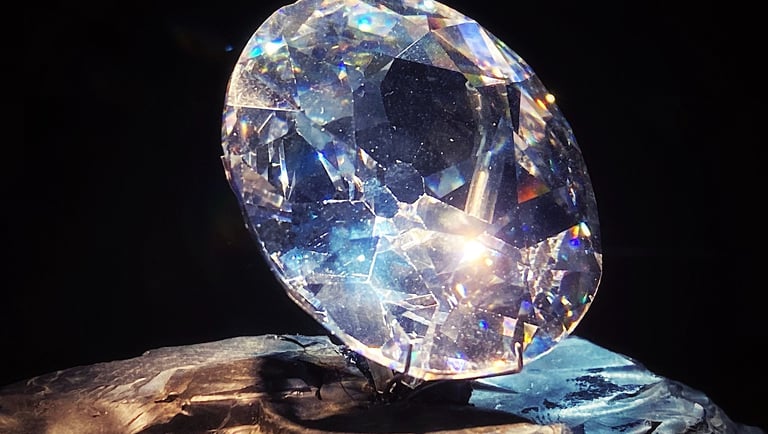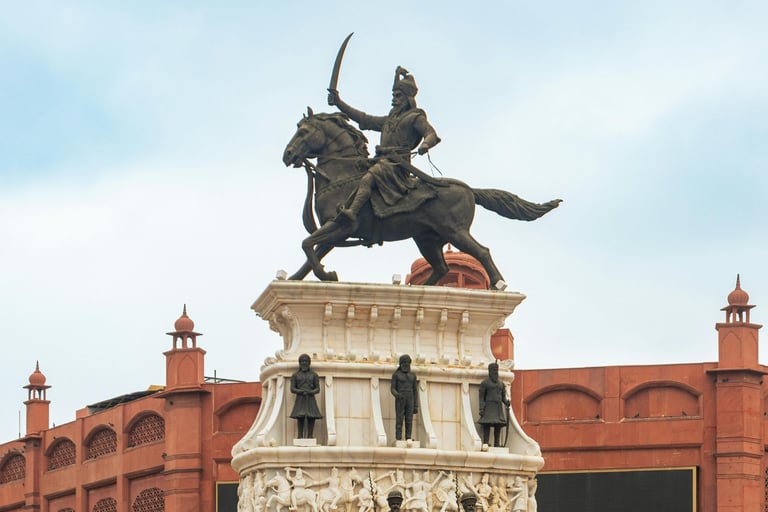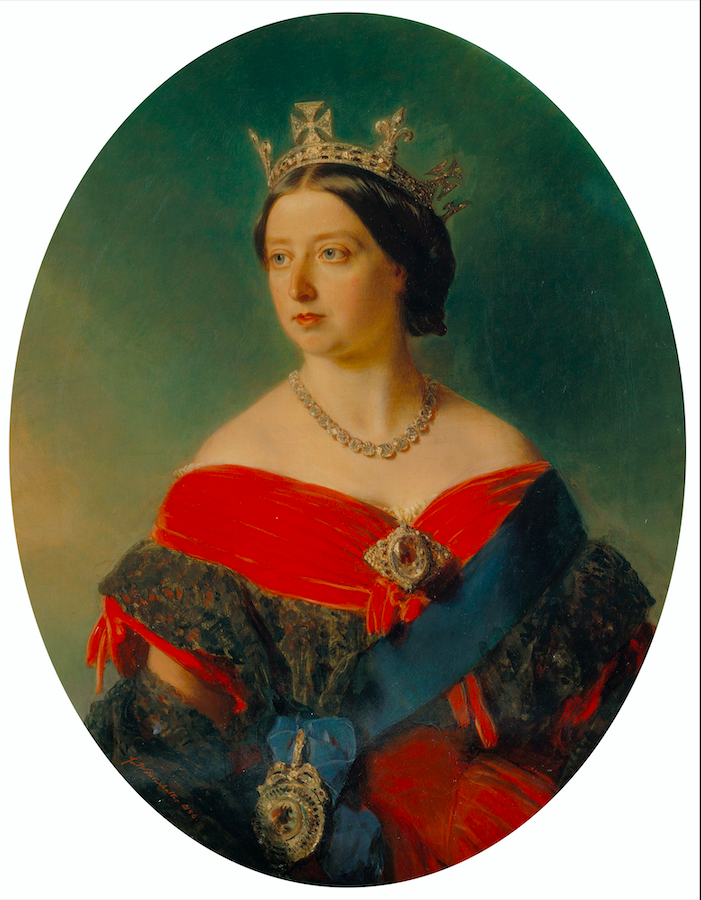The Kohinoor: A Jewel of Power, Controversy, and Legacy
The Kohinoor diamond has captivated the world with its unmatched brilliance and rich history. But what if its journey holds secrets that go beyond its glittering surface? Could this gem’s legacy reveal more than we ever imagined?
MINDMUSE


In the hushed galleries of the Tower of London, the Kohinoor glows with a quiet brilliance, encased in the Crown Jewels of the British monarchy. Visitors stand transfixed, captivated by its radiance, unaware of the centuries-long odyssey that brought it here—a tale that began in the sun-drenched lands of southern India.
The Kohinoor was born deep within the Kollur mine, nestled along the Krishna River in modern-day Andhra Pradesh. This mine, part of the famed Golconda region, was renowned for producing some of the most exquisite diamonds the world had ever seen. Among them was the Kohinoor, its unparalleled clarity and size setting it apart as a gem destined for greatness.
In the 13th century, this dazzling diamond came into the possession of Ganapati Deva, the illustrious ruler of the Kakatiya dynasty. From his capital in Orugallu (modern Warangal), Ganapati Deva oversaw a prosperous kingdom enriched by culture, commerce, and conquest. Recognizing the Kohinoor as more than a jewel, he enshrined it in the temple of the goddess Bhadrakali. Set upon the deity’s forehead, the diamond was revered as a divine protector of the kingdom, a symbol of celestial favour and unshakable power.
Following Ganapati Deva’s reign, the diamond passed to his daughter, Rudrama Devi, a trailblazing queen celebrated for her military prowess and administrative brilliance. She guarded the Kohinoor not only as a sacred artefact but as a testament to her lineage’s divine right to rule. However, the stability of the Kakatiya dynasty would soon be challenged by the rising ambitions of the Delhi Sultanate.
In 1310, Malik Kafur, a general of Alauddin Khilji, led a campaign into the Deccan that culminated in the defeat of the Kakatiyas. As Warangal fell, the Kohinoor was seized along with other treasures, becoming a prized trophy of conquest. It was now part of the immense treasure that flowed into the hands of the Khilji rulers, who had seized control of the Delhi Sultanate. The diamond, whose origins were rooted in divine sanctity, now became a symbol of the Sultanate’s imperial power. For years, it rested in the royal treasury, likely untouched, serving as a dazzling but passive witness to the shifting fortunes of the Khilji dynasty.
The Kohinoor’s path through history had only just begun. From the hands of devout rulers to the coffers of conquerors, it would pass through dynasties, empires, and continents, its legacy growing with every transfer.
The Kohinoor's fate took a new turn with the rise of the Tughluq dynasty in 1320. When Ghiyath al-Din Tughluq, the founder of the Tughlaq dynasty ascended to the throne of Delhi, he inherited not only the Sultanate’s wealth but also the prestigious Kohinoor. Though little is known about its precise use during this period, the diamond likely retained its status as a symbol of legitimacy and divine favour, as successive rulers believed such treasures carried the blessings of the heavens. The Kohinoor's presence within the Tughluq court would have added an air of invincibility to their reign, even as the empire faced internal unrest.
However, the Kohinoor’s journey was far from over. In 1398, the fierce conqueror Timur, also known as Tamerlane, marched toward Delhi, his military campaigns renowned for their brutality. After devastating the city, Timur carried off a vast collection of treasures, including, according to many accounts, the Kohinoor. The diamond was transported from Delhi to Samarkand, adding to Timur’s renowned hoard of imperial riches.
For nearly a century, the Kohinoor remained in Central Asia, housed within the Timurid empire. It passed through the hands of Timur’s descendants, who, despite the fragmentation of the empire after Timur’s death, continued to hold the diamond as a symbol of their ancestral grandeur. It is believed that the diamond’s brilliance served not only as a material treasure but also as a token of their connection to Timur’s legendary conquests.
In the early 16th century, the Kohinoor’s path led it back to India, this time under the Mughal Empire. Babur, the first Mughal emperor and a descendant of Timur, inherited much of his ancestor’s wealth, including the famed Kohinoor. Though Babur did not elaborate extensively on the diamond in his memoirs, the Baburnama refers to a great diamond possessed by the Mughal court, which many believe to be the Kohinoor. By the time of Akbar’s reign, the Kohinoor was firmly ensconced in the Mughal imperial regalia, often displayed as a symbol of the dynasty’s strength, wealth, and sophistication.
During the reign of Shah Jahan, the Kohinoor reached its pinnacle of glory. It was enshrined in the magnificent Peacock Throne, a dazzling creation studded with precious gems, with the Kohinoor placed at its very heart. The throne, symbolising the divine right to rule, became a visual testament to the might of the Mughal Empire. The diamond, once a symbol of power in distant kingdoms, now stood as the crowning jewel of a vast and prosperous empire, reflecting the splendour and strength of Shah Jahan's rule.
Yet, as history often weaves its tales, the Kohinoor’s brilliance was not to remain confined to the throne for long. The Mughal Empire, once an unshakable force, was beginning to weaken, facing internal strife and external pressures. The grand throne that housed the Kohinoor would soon witness its downfall, and with it, the diamond's fate would take another dramatic turn.
In 1739, Nader Shah, the Persian conqueror, swept into India with a merciless ambition. His invasion of Delhi, devastating and swift, would forever change the Kohinoor’s path. The grandeur of the Mughal Empire, once symbolised by the diamond, now fell into the hands of a new ruler, one who would claim it as part of his plunder from the city.
The Kohinoor: Nader Shah’s Triumph and a New Name
When Nader Shah beheld the Kohinoor amidst the dazzling treasures plundered from the Mughal court, its brilliance seemed to outshine the riches of empires. Overcome by its radiance, he exclaimed in awe, "Koh-i-Noor!"— “Mountain of Light.” With that single, poetic utterance, the diamond was forever renamed, its new title reflecting both its luminous beauty and the magnitude of his triumph.
Once the heart of Emperor Shah Jahan’s legendary Peacock Throne, the Kohinoor symbolised the grandeur of the Mughal Empire. Now, it adorned Nader Shah’s victory, a jewel transformed into an emblem of Persian supremacy. Even his consort, mesmerised by its magnificence, marvelled at its worth. She declared that if a man cast four stones—north, south, east, and west—and another to the heavens, and the space they encircled was filled with gold, it would still fail to equal the value of the Kohinoor. Her words immortalised the diamond as a treasure beyond compare, one that embodied unparalleled wealth and majesty.
Under Nader Shah’s rule, the Kohinoor became more than a trophy; it was a testament to his domination, a beacon of his empire’s strength. Yet, as history would reveal, the diamond’s journey was far from over, its legacy shaped by each hand it passed through.
The brilliance of Nader Shah’s reign was extinguished as violently as it had ignited. In 1747, his assassination plunged Persia into chaos, fracturing the empire he had forged. Amid the bloodshed and betrayal that followed, his famed treasury became the ultimate prize. The Kohinoor, already a symbol of imperial might, drew the gaze of many, each plotting to claim it for their own.
Ahmad Shah Durrani, once a trusted commander under Nader Shah, emerged as the most cunning of these aspirants. As rival factions tore into Nader’s legacy, Ahmad Shah orchestrated a deft manoeuvre. Relying on both his military acumen and his understanding of fractured loyalties, he rallied his supporters to secure a share of the fallen emperor’s treasures. With subtlety and force, he laid claim to the Kohinoor—not through a climactic battle but through calculated action in the shadow of upheaval.
Now in possession of the fabled diamond, Ahmad Shah returned to Kandahar, where he established the Afghan Empire. The Kohinoor, its light unyielding even in the darkest of times, became a symbol of his newfound sovereignty. What was once the pride of Persia now reflected the rising ambition of Afghanistan, its journey etched with power, strategy, and survival.
The Kohinoor: From Afghanistan to Punjab
The Kohinoor’s brilliance could not save the Afghan Empire from decline. After Ahmad Shah Durrani’s death, the diamond passed to his successors, becoming less a symbol of conquest and more a relic of fading glory. By the early 19th century, Shah Shuja Durrani, the last notable ruler of the dynasty, found himself dethroned, imprisoned, and stripped of power. His brother, Mahmud Shah, supported by rival tribal factions, orchestrated his overthrow in 1809, exploiting Shuja’s inability to hold the fractious empire together. Alone, he clung to the Kohinoor as his last hope, the gem a silent witness to his fall from grace.
Fate led Shah Shuja to Punjab, seeking refuge under Maharaja Ranjit Singh, whose empire was at its zenith. Ranjit Singh, the "Lion of Punjab," was not only a military genius but also a man of great spiritual depth. The Maharaja, sharp-eyed and ambitious, recognised the value of the jewel—not merely its beauty, but the aura of legitimacy and authority it carried. Promising protection, Ranjit Singh negotiated for the Kohinoor, and Shah Shuja, desperate to regain his throne, reluctantly handed it over. Thus, in 1813, the Kohinoor became the crowning jewel of the Sikh Empire.
However, Ranjit Singh, ever cautious and astute, was not quick to accept the Kohinoor without ensuring its authenticity. With its legendary reputation, the diamond could easily have been the subject of deceit. To confirm its true identity, the Maharaja personally examined the jewel, its facets gleaming under his scrutiny. Satisfied that it was indeed the fabled Mountain of Light, Ranjit Singh added it to his treasures, not just as a prized possession, but as a symbol of his rising power. The Kohinoor, now in his hands, became more than a gem; it was an emblem of the Sikh Empire’s strength and legitimacy, further solidifying his reign.
Adorning himself with the diamond, Ranjit Singh wore it as part of his crown and jewellery, making it the centrepiece of his royal regalia. It was displayed on ceremonial occasions, its light reflecting the grandeur of Punjab.
Kohinoor: A diamond that shines with the weight of history.(Courtesy: World History Encyclopedia)


The Lion of Punjab, a ruler who shaped an empire.
In his later years, however, the Maharaja’s perspective shifted. Deeply devout, he came to view the Kohinoor as a sacred object meant for the gods. He planned to donate it to the Puri Jagannath Temple in Odisha as an offering to Lord Jagannath, a gesture of spiritual devotion. However, fearing the loss of such a priceless gem and its political significance, his advisors dissuaded him. In addition, Ranjit Singh’s failing health and the increasing instability in his empire prevented him from carrying out this plan.
When Ranjit Singh died in 1839, the Kohinoor passed to his successors. But after his death, the once-mighty Sikh Empire began to fragment, weakened by internal strife and the relentless pressure from the British. The culmination of this tension came with the Second Anglo-Sikh War in 1849, resulting in the defeat of the Sikh forces and the annexation of Punjab by the British. Following the annexation of Punjab, the fate of the Kohinoor mirrored the tragic fall of the Sikh Empire. In the wake of the British victory, Maharaja Duleep Singh, a mere child of only 11 years and a puppet of the conquerors, was forced to surrender the diamond that had long symbolised the grandeur of his ancestors. The Kohinoor, once a glittering emblem of Sikh strength and heritage, was relinquished to the British, marking the painful end of an empire that had stood proud for generations.
Once the Kohinoor was handed over to the British in 1849, it was quickly transported to England as part of the spoils of war. The British government, eager to display its power and newfound treasures, decided to exhibit the Kohinoor as a symbol of their conquest of India.
In 1850, Queen Victoria was presented with the diamond, and it was soon placed in the Tower of London, where it became part of the British Crown Jewels. However, the Kohinoor’s journey was far from over.
Upon its arrival in Britain, the Kohinoor's awe-inspiring size—at an impressive 186 carats—quickly commanded attention, but it was not without its flaws. The rough, uneven cut and visible imperfections that marred its surface failed to capture the brilliance that its reputation promised. Though it carried an immense historical weight, the diamond’s lustre seemed muted, restrained by the very characteristics that once made it a prized possession.
The British were initially disappointed, as the jewel, despite its grandeur, did not live up to the expectations of a symbol that had already transcended empires. Determined to bring out its full glory, Prince Albert, Queen Victoria's consort, ordered the Kohinoor to be recut. In 1852, skilled diamond cutters were entrusted with this delicate task. The stone was reduced to 105.6 carats, and its flaws were meticulously polished away. What emerged was a dazzling gem, more symmetrical, with a fiery sparkle that now captured the eye as never before.
The Kohinoor became an integral part of the British royal regalia, initially worn by Queen Victoria as a brooch and circlet. Over the years, it was set into the crowns of successive queens, symbolising British imperial power. In 1902, it adorned Queen Alexandra’s crown for Edward VII’s coronation, and in 1911, it was placed in Queen Mary’s crown for George V’s coronation. The diamond was later set in the crown of Queen Elizabeth, the Queen Mother, for the 1937 coronation of George VI.


Queen Victoria's Kohinoor brooch symbolised imperial grandeur.
An intriguing twist in the Kohinoor’s legacy came during King Charles III’s coronation in 2023, when the iconic diamond was notably absent. Despite being part of the crown jewels for centuries, it was left out of the ceremony. The omission likely stemmed from the controversial history surrounding the diamond, tied to colonialism and the British Empire’s legacy. This decision reflected a conscious shift in modern royal sensibilities, distancing the monarchy from symbols of conquest. As the coronation proceeded, the focus shifted to other historical treasures, acknowledging the evolving relationship between the crown and its past.
Today, the Kohinoor rests in the Tower of London, its story a testament to its enduring allure and the legacy it carries as a symbol of empire and royalty. Its brilliance continues to captivate, embodying the history of a diamond that has been coveted, altered, and revered through centuries of conquest and monarchy.
A Contested Legacy
The Kohinoor’s journey, from a sacred temple relic to a centrepiece of British regalia, reflects centuries of shifting power and ambition. While it gleams in the Tower of London, drawing admiration from millions, its presence in Britain remains a poignant reminder of its complex past. India, Pakistan, Afghanistan, and Iran all lay claim to the diamond, their histories intertwined with its glittering yet turbulent saga.
The British government asserts that the Kohinoor was acquired lawfully, but many argue its transfer was steeped in coercion, a shadow of imperial dominance. As voices calling for its return grow louder, the diamond remains more than a treasure—it is a prism through which beauty, power, and the echoes of history are endlessly refracted.
While the diamond’s journey continues to be a matter of national pride and claim, the Kohinoor's Curse is another layer of its mystique. Legend has it that the diamond brings misfortune to its male owners, a belief that persisted even as the Kohinoor passed through the hands of kings and empires. It was only when it came under the possession of female monarchs, from Queen Victoria to Queen Elizabeth, that it was said to have lost its cursed legacy. Thus, the Kohinoor remains a symbol of both beauty and misfortune, its legacy entwined with both power and mystery.
The Kohinoor, with its turbulent history and contested ownership, holds a mirror to the complexities of our past. It is a reminder that beauty and power are often intertwined with deep, sometimes painful, legacies. As we look at this extraordinary gem, we are urged to reflect on the true cost of conquest, the weight of history, and the responsibility that comes with the treasures of the past. In the end, the Kohinoor’s story is not just about the jewels we possess, but about how we choose to understand and honour the histories they represent. It challenges us to view our shared heritage with respect, compassion, and a commitment to reconciliation.
